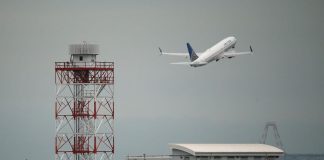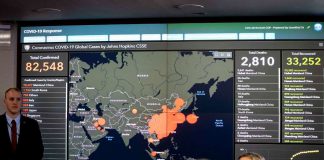OCTOBER 31, 2018
 Chinese tourists spend an average of $6,900 on each trip to the United States, and China sent over 350,000 college students here last year. – Robert Alexander/Getty Imagaes
Chinese tourists spend an average of $6,900 on each trip to the United States, and China sent over 350,000 college students here last year. – Robert Alexander/Getty Imagaes
Fewer Chinese business executives, tourists and students are visiting the United States, a sign that the trade war between Washington and Beijing might spread in unpredictable and costly ways.
The nascent decline — visible in visa approvals and airline bookings — isn’t the result of official action by Beijing. But it highlights a potent weapon that China could use if the trade war persists: slashing the $60 billion that Chinese consumers spend each year on American services such as travel and tourism.
Already, 102,000 fewer Chinese people received business, leisure and educational visas from May through Septemberof this year compared with the same period last year, a 13 percent drop, according to State Department statistics.
Chinese airline reservations to U.S. destinations dropped 42 percent for the first week of October, a national holiday that normally means increased outbound trips, according to Skyscanner, a search engine owned by China’s largest travel company.
Unlike merchandise trade, for which President Trump often complains about the large deficit with China, the United States enjoys a sizable services surplus — making such commerce a large and potentially vulnerable target in a lengthy trade war. Since 2011, U.S. services trade with China has grown more than three times as fast as the shipments of goods that Trump usually focuses on.
“We have expected that they will try a whole range of things to encourage us to back down,” said a senior administration official, who requested anonymity to discuss internal deliberations. “It’s not going to work. But we would hope China wouldn’t do that.”
China’s done it before. During a diplomatic dispute with South Korea last year, the Chinese government banned the sale of package tours to Seoul and Jeju Island. The boycott cost South Korean businesses nearly $7 billion in just a few months, as Chinese tourists obeyed their government’s orders to head elsewhere.
Launching a similar boycott against the United States would risk alienating millions of middle-class Chinese who put a premium on American education and thirst for American vacations.
But a consumer embargo could deprive the U.S. travel industry of its most lucrative customers — Chinese tourists spend an average of $6,900 on each trip — and hurt American universities that have enjoyed a surge in enrollment by Chinese students.
China last year sent more than 350,000 college students to the United States, almost twice as many as India, the No. 2 source.
At the University of Illinois at Urbana-Champaign, one of the most popular options for students from places like Beijing or Shanghai, Chinese students last year numbered 5,845, compared with just 950 a decade earlier. Foreign students are attractive to such schools because they generally pay far higher tuition than state residents do.
If China chooses to widen the trade war by curbing its citizens’ spending on travel, financial services or consulting contracts, the United States would feel the impact more quickly than if Beijing levied additional tariffs on American goods, according to Joy Dantong Ma, a research associate at the Paulson Institute in Chicago.
Chinese manufacturers need time to rearrange complex supply chains, but Chinese consumers can easily change vacation plans to visit Tuscany rather than Napa Valley, she said.
“If it’s going to escalate, you’d expect it to move to other channels like tourism,” Ma said. “The services industries are very different from goods exports. When demand for some thing disappears, you don’t see it immediately. But when demand for services goes, the numbers drop off right away.”
By far the biggest services category is travel and tourism, which last year brought American airlines, hotels and tourist operators $32 billion, twice as much as all U.S. aircraft sales to China, according to the Commerce Department.
“We have a good thing going with China,” said Jonathan Grella, executive vice president for public affairs at the U.S. Travel Association, an industry group that met last month with Trump at the White House to share their concerns about a decline in foreign tourist arrivals.
Before Deng Xiaoping began opening the economy to foreign influence in the late 1970s, Chinese citizens who wanted to travel were required to obtain the permission of their work units and local police authorities. Tourist departures were minuscule.
But as China has grown more prosperous, the number of Chinese going abroad has soared. Nearly 3 million visitors arrived in the United States in 2016, the most recent annual data available, up from just 525,000 in 2009, according to the Commerce Department.
“This is not just any market,” said Grella, who says his members have yet to detect a visitor decline. “China is viewed differently — the sheer size and economic potential.”
Chinese leaders may hesitate to boycott the United States, however, for fear of angering middle-class citizens who covet American diplomas for their children or just want to see Hollywood or Manhattan. In July, when a young man from Inner Mongolia detonated a small bomb near the U.S. Embassy in Beijing, people were back in the outdoor visa line less than an hour later, even as the bomber’s blood pooled on the sidewalk.
“This so-called trade war is just a political game between state leaders of China and the U.S. . . . If you decided to not travel to the U.S. just because you hate Trump, then you would probably also have joined a boycott against U.S. products if Hillary Clinton was president. Nationalism is not going to take us anywhere,” said a 50-year-old man who applied this month for a visa to visit Los Angeles, San Francisco and Las Vegas and would provide only his surname, Zhou. “Money and curiosity is.”
Zhou waited in line outside the U.S. Embassy in Beijing for 6½ hours to submit his visa form, an indication that blacklisting the United States would be far tougher than barring Chinese travelers from visiting South Korea.
“I just think it’s unlikely,” said Andy Rothman, an investment strategist with Matthews Asia. “The U.S. is a bigger and more important place than Korea. The ties are more important. There’d be a lot of pushback from Chinese people.”
So far, the dispute between the world’s two largest economies has been confined to their $635 billion in annual goods trade. Trump has imposed tariffs on roughly half of what Americans buy from China every year, and China has retaliated with similar levies on most of its smaller volume of orders from the United States.
Because China buys far less from the United States than it sells to Americans, it can’t match Trump’s tariffs dollar for dollar. Chinese officials for now don’t appear eager to escalate the conflict, hoping that a negotiated outcome after the U.S. congressional elections remains possible.
But that could change if negotiations stall — and both sides appear to be digging in for a fight. Trump and Chinese President Xi Jinping are scheduled to meet on the sidelines of the G-20 summit next month in Buenos Aires, but few analysts expect a diplomatic breakthrough.
“President Trump is serious about it, that if they don’t behave a little better, stop stealing our intellectual property, lower their tariffs on our products, then, you know, this could continue longer,” Kevin Hassett, the chairman of the White House Council of Economic Advisers, told CNBC earlier this month.
Trade-war tensions are rattling nerves on both sides of the Pacific. In July, the Chinese Embassy in Washington warned its citizens that traveling to the United States risked high medical bills, gun violence and street crime. “Public security in the United States is not good,” the embassy said.
The alert contributed to the United States dropping to No. 9 on a list of the most popular destinations for Chinese tourists, down from No. 6 in 2017, according to Ctrip, the largest travel company in China.
In Los Angeles, Chinese tourists’ most-visited U.S. destination, tourism officials are cautious about potential trade-war fallout. The city’s tourism board, which has offices in four Chinese cities, says the 1.2 million Chinese visitors expected this year are more than twice the number who came in 2013.
Along with seeing traditional attractions such as Universal Studios or a Los Angeles Lakers game, many Chinese tourists also shop for gifts to bring home, said Kathy Smits, vice president of the Los Angeles Tourism & Convention Board.
“We are absolutely keeping a close eye on it because it is a market that’s impacted by what destinations are looked upon favorably,” Smits said. “Just because we’re positive right now doesn’t mean there couldn’t be a change in the short term.”
Courtesy/Source: Washington Post









































































































